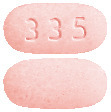Notes
Distributed by Wagner Pharmaceuticals
1 Name of Medicine
Ezetimibe, simvastatin.
2 Qualitative and Quantitative Composition
Ezetimibe/Simvastatin-WGR is available for oral use as tablets containing:
10 mg of ezetimibe and 10 mg of simvastatin (Ezetimibe/Simvastatin-WGR 10/10);
10 mg of ezetimibe and 20 mg of simvastatin (Ezetimibe/Simvastatin-WGR 10/20);
10 mg of ezetimibe and 40 mg of simvastatin (Ezetimibe/Simvastatin-WGR 10/40);
10 mg of ezetimibe and 80 mg of simvastatin (Ezetimibe/Simvastatin-WGR 10/80).
Excipients with known effect. Contains sugars (as lactose).
For the full list of excipients, see Section 6.1 List of Excipients.
3 Pharmaceutical Form
Ezetimibe/Simvastatin-WGR 10/10 [10 mg ezetimibe/ 10 mg simvastatin]. Light pink to pink colored with mosaic appearance, capsule shaped biconvex uncoated tablets '335' on one side and plain on other side.
Ezetimibe/Simvastatin-WGR 10/20 [10 mg ezetimibe/ 20 mg simvastatin]. Light pink to pink colored with mosaic appearance, capsule shaped biconvex uncoated tablets '336' on one side and plain on other side.
Ezetimibe/Simvastatin-WGR 10/40 [10 mg ezetimibe/ 40 mg simvastatin]. Light pink to pink colored with mosaic appearance, capsule shaped biconvex uncoated tablets '337' on one side and plain on other side.
Ezetimibe/Simvastatin-WGR 10/80 [10 mg ezetimibe/ 80 mg simvastatin]. Light pink to pink colored with mosaic appearance, capsule shaped biconvex uncoated tablets '338' on one side and plain on other side.
4 Clinical Particulars
4.9 Overdose
Ezetimibe/simvastatin. No specific treatment of overdosage with ezetimibe/simvastatin can be recommended. In the event of an overdose, symptomatic and supportive measures should be employed. Co-administration of ezetimibe (1000 mg/kg) and simvastatin (1000 mg/kg) was well-tolerated in acute, oral toxicity studies in mice and rats. No clinical signs of toxicity were observed in these animals. The estimated oral LD50 for both species was ezetimibe ≥ 1000 mg/kg/simvastatin ≥ 1000 mg/kg.
For information on the management of overdose, contact the Poisons Information Centre on 13 11 26 (Australia).
Ezetimibe. In clinical studies, administration of ezetimibe, 50 mg/day to 15 healthy subjects for up to 14 days, 40 mg/day to 18 patients with primary hypercholesterolemia for up to 56 days, and 40 mg/day to 13 patients with homozygous sitosterolemia for 26 weeks, was generally well tolerated.
A few cases of overdosage have been reported; most have not been associated with adverse experiences. Reported adverse experiences have not been serious.
Simvastatin. A few cases of overdosage have been reported; the maximum dose taken was 3.6 g. All patients recovered without sequelae.
5 Pharmacological Properties
5.3 Preclinical Safety Data
Genotoxicity. Ezetimibe/simvastatin. Ezetimibe alone or in combination with simvastatin did not cause gene mutation in bacteria or chromosomal damage in human peripheral lymphocytes or bone marrow cells in mice.
Carcinogenicity. Ezetimibe/simvastatin. Carcinogenicity studies with ezetimibe/simvastatin combinations have not been performed.
Ezetimibe. Two-year dietary studies with ezetimibe alone in mice and rats showed no evidence of carcinogenic potential. The highest ezetimibe dose (500 mg/kg/day) in mice corresponds to exposure levels approximately 4 and ≥ 150 times the adult human exposure for ezetimibe and total ezetimibe, respectively, based on AUC. Exposures in rats at the highest dose (1500 mg/kg/day in males and 500 mg/kg/day in females) correspond to approximately 2 and 14 times the adult human exposure for ezetimibe and total ezetimibe, respectively.
Simvastatin. Carcinogenicity studies have been conducted in mice at oral doses ranging from 1 to 400 mg/kg/day and in rats at doses of 1 to 100 mg/kg/day. Hepatocellular adenomas and carcinomas were observed in both sexes of both species at doses greater than 25 mg/kg/day. Plasma drug levels in rats at this no-effect dose level, expressed as the AUC for enzyme inhibitory activity, were 3 to 11 times greater than those in humans at the maximum recommended dose, whereas serum levels at the no-effect level in mice were similar to those in humans. Additional findings in mice were increased incidences of pulmonary adenomas at doses greater than 25 mg/kg/day, and of Harderian gland adenomas at 400 mg/kg/day. In rats, the incidence of thyroid follicular adenoma was increased in females at doses greater than 5 mg/kg/day and in males at doses greater than 25 mg/kg/day. These thyroid tumours were associated with focal cystic follicular hyperplasia and may be a secondary effect reflective of a simvastatin-mediated enhancement of thyroid hormone clearance by the liver.
6 Pharmaceutical Particulars
6.7 Physicochemical Properties
Ezetimibe. The chemical name of ezetimibe is 1-(4-fluorophenyl)-3(R)-[3-(4-fluorophenyl)-3(S)- hydroxypropyl]-4(S)-(4- hydroxyphenyl)-2-azetidinone. The empirical formula is C24H21F2NO3 and its molecular weight is 409.4.
Ezetimibe is a white, crystalline powder that is freely to very soluble in ethanol, methanol, and acetone and practically insoluble in water.
Chemical structure.
https://stagingapi.mims.com/au/public/v2/images/fullchemgif/CSEZETIM.gif CAS number. 163222-33-1.
Simvastatin. Simvastatin, an inactive lactone, is hydrolysed to the corresponding β-hydroxyacid form, which is an inhibitor of HMG-CoA reductase. Simvastatin is butanoic acid, 2,2-dimethyl-,1,2,3,7,8,8a- hexahydro-3,7- dimethyl-8-[2-(tetrahydro-4-hydroxy-6-oxo-2H-pyran-2-yl)-ethyl]-1-naphthalenyl ester, [1S- [1α,3α,7β,8β(2S*,4S*),-8aβ]]. The empirical formula of simvastatin is C25H38O5 and its molecular weight is 418.57.
Simvastatin is a white to off-white, non-hygroscopic, crystalline powder that is practically insoluble in water, and freely soluble in chloroform, methanol and ethanol.
Chemical structure.
https://stagingapi.mims.com/au/public/v2/images/fullchemgif/CSSIMVAS.gif CAS number. 79902-63-9.
7 Medicine Schedule (Poisons Standard)
Prescription only medicine (S4).
Summary Table of Changes
https://stagingapi.mims.com/au/public/v2/images/fulltablegif/EZSWGRST.gif

